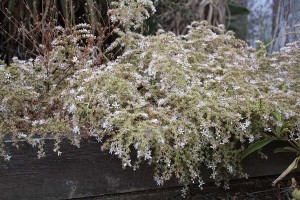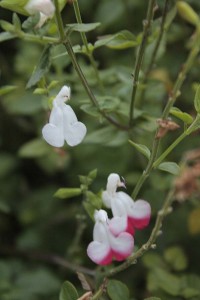
Update #1: The gopher chronicles (Original post: Cooking for Vermin)
It’s been three weeks since I tried to ward off gophers by using extra-hot chili powder. People want to know if it works.
The conclusion: There’s no sign of obvious damage from pocket gophers in the treated area. The plants are growing and blooming normally. That might sound like success, but there hasn’t been any gopher damage anywhere else in the garden, either. So it’s inconclusive at this point. But I’ll post as the season goes on. I really really want this to work.
Update #2: Life post-hacking (Original post: I was hacked)
After I realized that my blog was hacked I cleaned out what looked like the problem code. But two days later the WordPress Pharma Hack was back. I did more drastic cleanup after that, and it looks like that took care of the problem.

Even after cleanup, because it takes days to weeks for Google to catch up and reindex everything on a site, searches for my blog showed many titles for my posts as promising ways to buy various drugs without prescription. Even as recently as Wednesday, last week, the number one blog keyword was “Prescription.” For a garden blog it’s pathetic to have that word ahead of the next four on the list: “garden,” “plants,” “blog” or “landscape.” But the tide turned on Thursday, and the good words continue to rise as the hacker words sink.
Update #3: Aloe, good-bye (Original post: Exotic plant, exotic pest)
It’s been almost a year since I mentioned that my specimen Aloe barberae (aka A. bainesii) was in serious decline. Aloe mites had attacked the plant and I was blaming its fate on them. The plant continued to decline to the point that it had just a few growing tips that kept getting smaller and smaller. Something was very wrong and we cut the plant back to a stump one to two months later, leaving three small pups that were springing from the lowest two feet of the plant.

Since then even those little pups have failed to thrive. Signs of mites have been few, so I’m beginning to think that some other cause is responsible for the problems. Hypothesis #1 at the moment: pocket gophers eating the roots. My main reason for thinking this is that there’s another A. barberae just a few feet away that looks robust, with none of the signs of illness the big plant was showing. I’ll keep my hope up for that plant.

In the meantime, aloes being aloes, I figured that all the little branch tips I cut off might root easily. I treated all the chunks with miticide, stuck them in potting mix and kept them just-moist. All three took.
Quite frankly I’m not sure there’s room in the front for two giant aloes I had there in the first place–placing the two original plants so close was a mistake. So I gave two of the rooted plants to people in my office who were eager to grow this terrific plant. I still have one rooted plant, along with a half dozen more unrooted branch tips sitting on my greenhouse floor that are still green, almost a year later. I might end up with an impressive aloe in a pot if I can’t find a place for it. And if I root the remaining branch tips I could have a half-dozen more giveaways.
The original plant looks doomed, but pieces of the original clone live on. In the life and death world of gardens that’s almost a happy ending.
Update #4: Crest-fallen (Original post: Mutant Primrose)
In case you’re wonderng what happened to the mutant Hooker’s evening primrose from a May 12 posting, it looks like the weight of the extra tissue on the crested growing tip was more than the stem could keep aloft. Within a week of the original photo, the stem flopped to the ground, where it has stayed, still alive, but not thriving…


Update #5: A different outcome for a crested growth (Original post: Deformity or Biological Wonder?)
My last progress report is on this mutant crested growth of a Euphorbia lambii. Since I posted on it in June of 2009, the plant seems to have incorporated the crest into its continued growth patterns, unlike on what was going on with the primrose above. Still, you can tell that the growth pattern isn’t quite what normal plants go through. Still interesting, two years later…














